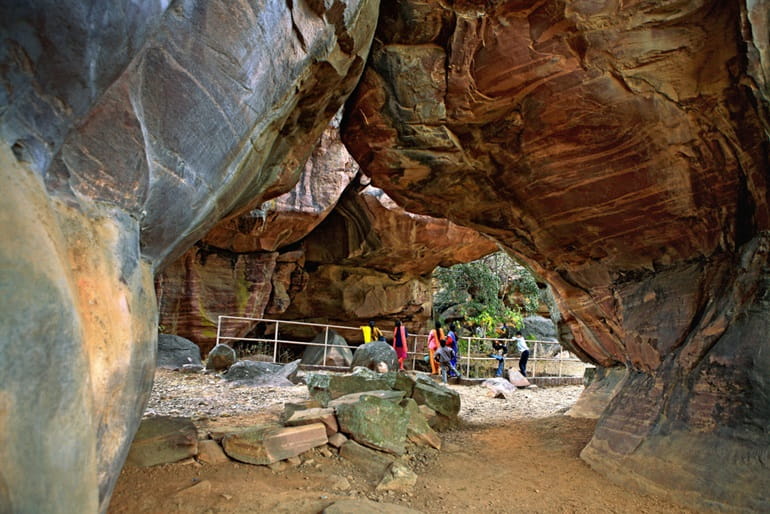
Bhimbetka caves, located in the central Indian state of Madhya Pradesh, hold immense significance in the world of art and archaeology. These rock shelters provide a glimpse into the rich artistic traditions and cultural heritage of early humans. Let’s explore the time period, importance, emotional reflections, insights into early human lifestyle, geographical situation, and other fascinating aspects of the Bhimbetka cave art in a detailed blog.
Bhimbetka Caves: Unveiling the Ancient Canvas of Early Human Art and Lifestyle
Introduction
The Bhimbetka caves, nestled amidst the Vindhya mountain range, transport us back in time to the dawn of human civilization. Dating back thousands of years, these rock shelters have preserved a treasure trove of prehistoric art, offering invaluable insights into the lives and emotions of our early ancestors. This blog explores the time period, significance, emotional expressions, and the wealth of information about early human lifestyles that the Bhimbetka cave art has unravelled. Join us on this captivating journey through the corridors of time.
- Time Period and Significance of Bhimbetka Caves
The Bhimbetka caves bear witness to a remarkably long history, with evidence of human habitation spanning from the Palaeolithic era to the historic period. The rock shelters, discovered in 1957 by Dr. Vishnu Wakankar, have been designated as a UNESCO World Heritage Site since 2003. This recognition underscores their global importance and ensures their preservation for future generations.
The Emotional Reflections in Bhimbetka Cave Art
The art of Bhimbetka encapsulates a vivid range of human emotions, offering us a unique glimpse into the mindset and experiences of our early ancestors. The paintings, created using natural pigments, depict various scenes of everyday life, ritualistic practices, hunting expeditions, communal gatherings, and mythical narratives. The rich symbolism and nuanced expressions found in these artworks evoke a deep sense of awe, wonder, joy, fear, and spiritual connection.
- Insights into Early Human Lifestyle
The art of Bhimbetka caves serves as a visual time capsule, allowing us to reconstruct aspects of early human lifestyles. Through the depictions of hunting scenes, communal activities, and ritualistic practices, we gain insights into their social structure, subsistence strategies, religious beliefs, and technological advancements. The paintings reveal the presence of diverse fauna, indicating the ecological context and the importance of hunting for sustenance. Additionally, the portrayal of communal activities suggests the development of social bonds and cooperative living. - Unveiling the Geographical Situation of Bhimbetka Caves
Situated in the heart of India, the Bhimbetka caves enjoy a unique geographical setting. Nestled within the rugged terrain of the Vindhya mountain range, the rock shelters are sheltered from harsh climatic conditions and erosion. The surrounding landscape comprises dense forests, perennial rivers, and abundant wildlife, providing early humans with a bountiful environment for survival and artistic expression. The geographical context of Bhimbetka further enriches our understanding of early human adaptation and their relationship with the natural world. - Preservation Efforts and Future Prospects
The preservation and conservation of the Bhimbetka caves are of paramount importance to safeguard this invaluable cultural heritage. Various measures, including the establishment of protective enclosures, controlled visitor access, and documentation of the cave art, have been undertaken. Collaborative efforts involving archaeologists, historians, and local communities are crucial for the continued preservation and study of Bhimbetka caves. Furthermore, ongoing research and technological advancements offer exciting prospects for enhanced interpretation, dating techniques, and preservation methods.

Conclusion
The Bhimbetka caves stand as testament to the artistic prowess, emotional depth, and profound cultural heritage of our early human ancestors. The paintings found within these rock shelters provide us with a visual narrative of their lives, beliefs, and interactions with the world around them. From the exhilaration of the hunt to the awe-inspiring depiction of mythical creatures, Bhimbetka cave art offers a captivating window into the past. Exploring these ancient artworks not only ignites our imagination but also deepens our understanding of the diverse tapestry of human history. Let us cherish and protect this artistic legacy, ensuring that the Bhimbetka caves continue to inspire and enlighten future generations.
